By Judy O’Mara
Take Closer Look at the Roses
The cool, wet spring weather is amazing for rose shrubs. They are blooming like crazy. However…if you take a closer look, you might notice that the blooms don’t last that long. They seem to fall apart and drop their petals very quickly. This is one of those instances where there actually is a disease involved. A fungal disease called Botrytis blight can cause tiny spots on the flower petals. If conditions are favorable (cool, high humidity, wet), then the blooms can look like they have the measles. Infected blooms quickly fell apart. The problem self corrects itself when the temperature increases and the weather dries out.
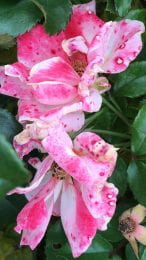
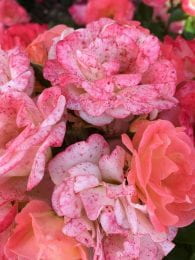
Fungi just Love Mulch
I planted some flowers and mulched the flower bed this weekend. When I opened the bag about twenty percent of the mulch had a white fungal mold. Questions about this issue turn up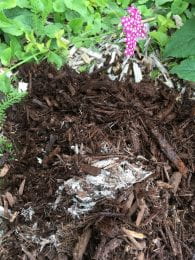 every spring. Basically mulch molds are wood decomposers. They occur as part of the natural ecosystem that breaks down organic matter. This is probably why we have to replace the mulch in our flower beds every year.
every spring. Basically mulch molds are wood decomposers. They occur as part of the natural ecosystem that breaks down organic matter. This is probably why we have to replace the mulch in our flower beds every year.
What triggers the prolific growth is a combination of wet conditions and large amounts of organic matter. Very likely the bag had a hole in it and water got inside.
Heavy amounts of mold can create a hydrophobic zone which can prevent water from getting to the plant roots. This can be avoided by breaking up the fungal mass.
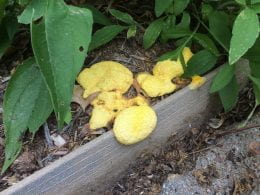 It is not necessary to use fungicides to get rid of them. They are pretty much present whether we see them or not.
It is not necessary to use fungicides to get rid of them. They are pretty much present whether we see them or not.
Another interesting mulch problem is Dog Vomit aka Slime mold.
Slime molds start out as a colorful, slimy mass that dries down to a powdery material. They are common in mulch or turf. They can even crawl up on lawn furniture. They are favored by cool, wet conditions and are easily knocked back with a stream of water from a hose or even a rake.
For more information on this interesting phenomenon check out this web site at the Utah State University Herbarium. https://herbarium.usu.edu/fun-with-fungi/slime-molds
Diplodia tip blight
Across the state of Kansas, the most common pine disease is Diplodia tip blight (aka Sphaeropsis tip blight). The disease attacks the new shoot growth as it emerges in the spring. About the end of May, new shoots visibly die back on the ends of the branches. Over time, the disease can develop as a canker further back and result in a die back of the entire branch.
![]()

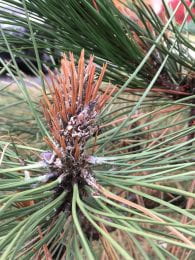
 This fungal disease is primarily a problem on mature pine plantings (ie crowded, with poor air flow). Over a period of many years (10-15), the disease slowly chews up the tree resulting in a tree that appears half dead. The black pepper speck, fungal fruiting bodies (pycnidia) on the back of the pine cone scales are a key diagnostic feature for Diplodia tip blight.
This fungal disease is primarily a problem on mature pine plantings (ie crowded, with poor air flow). Over a period of many years (10-15), the disease slowly chews up the tree resulting in a tree that appears half dead. The black pepper speck, fungal fruiting bodies (pycnidia) on the back of the pine cone scales are a key diagnostic feature for Diplodia tip blight.
Those are the facts, so…I was taken back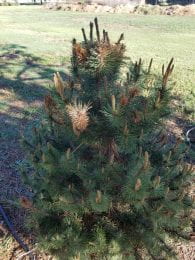 by two separate pine samples that came through the K-State Plant Disease Diagnostic lab last week. Both pines had Diplodia tip blight, causing a shoot blight of the new growth, but…they were from young trees (3-5yrs old)!
by two separate pine samples that came through the K-State Plant Disease Diagnostic lab last week. Both pines had Diplodia tip blight, causing a shoot blight of the new growth, but…they were from young trees (3-5yrs old)!
However…on one sample the new trees were planted next to a line of older pine trees, which was probably the source of the disease inoculum.